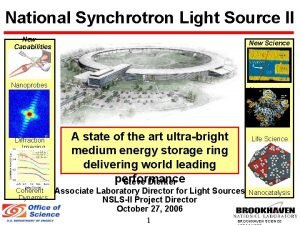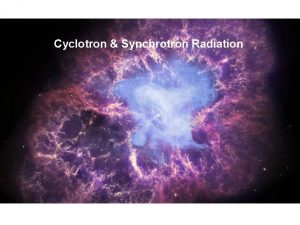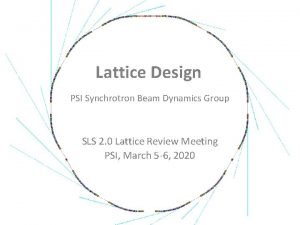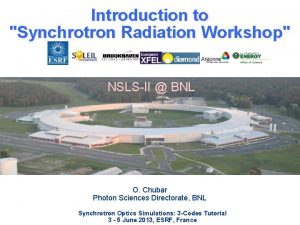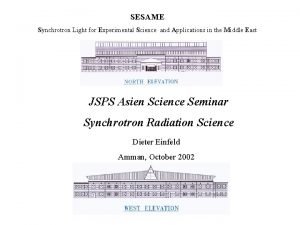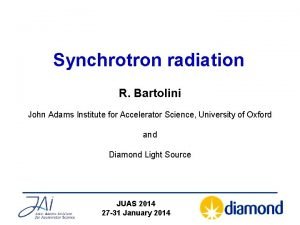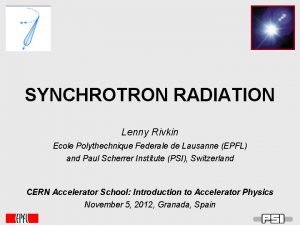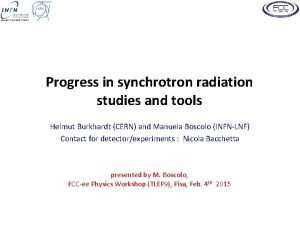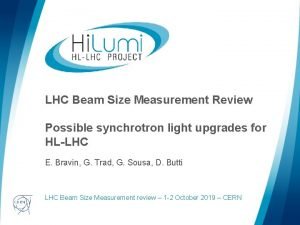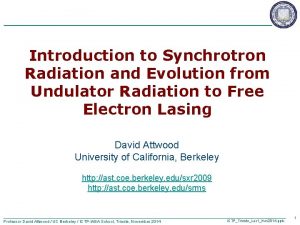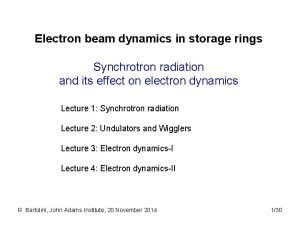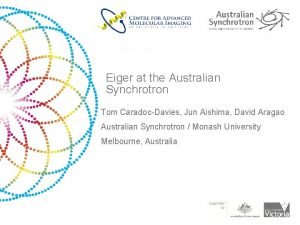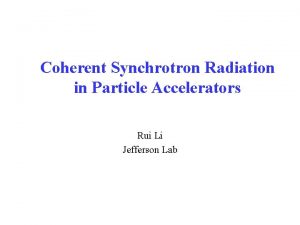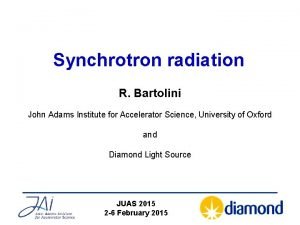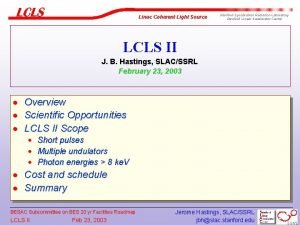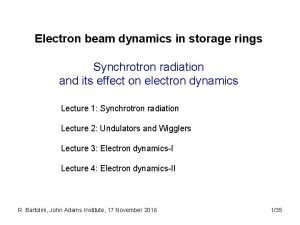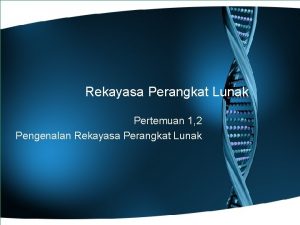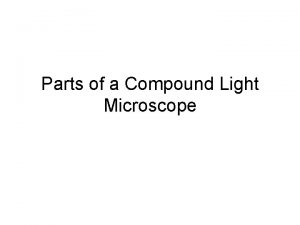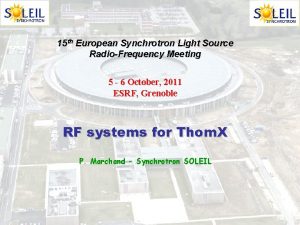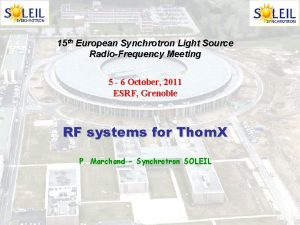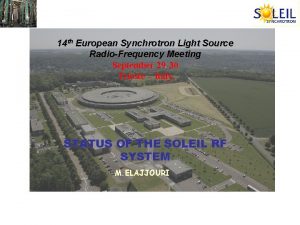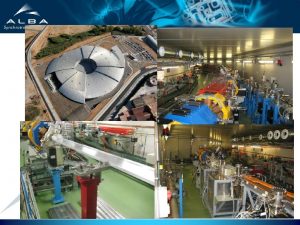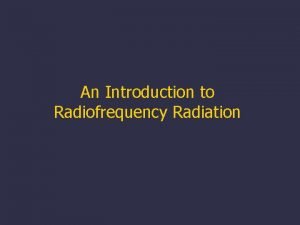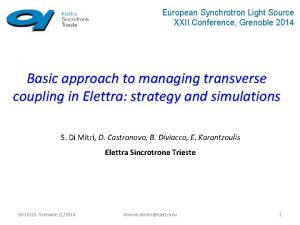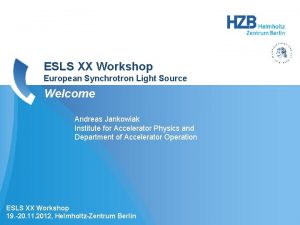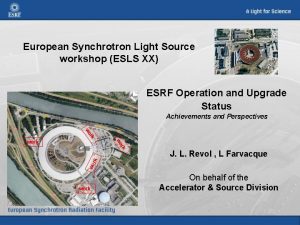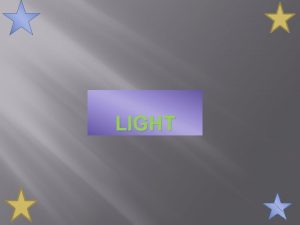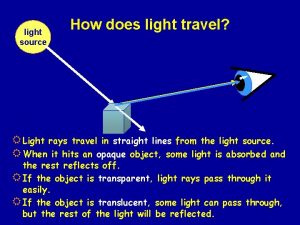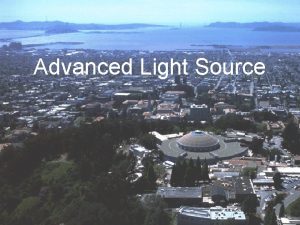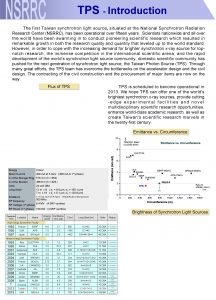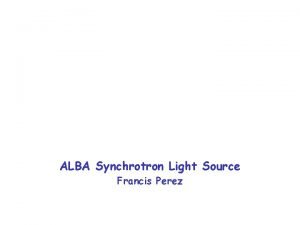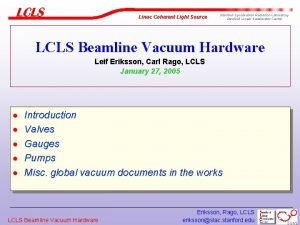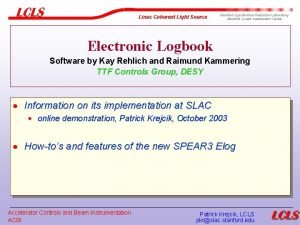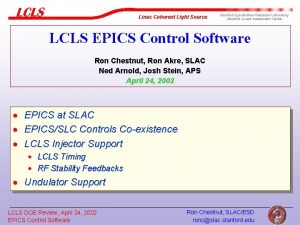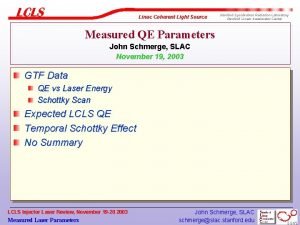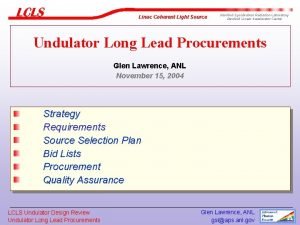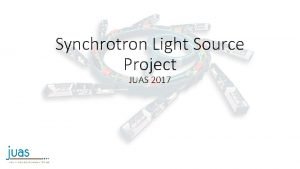15 th European Synchrotron Light Source RadioFrequency Meeting




















![Cavity transfer function with RF FB Amplitude [d. B] 0 -10 T = 150 Cavity transfer function with RF FB Amplitude [d. B] 0 -10 T = 150](https://slidetodoc.com/presentation_image_h/10033a359cefeab48abc9111b0dbb5c4/image-21.jpg)




- Slides: 25

15 th European Synchrotron Light Source Radio-Frequency Meeting 5 - 6 October, 2011 ESRF, Grenoble RF systems for Thom. X P. Marchand - Synchrotron SOLEIL

The Thom. X Project Compact source of hard X-rays (40 – 90 ke. V) Flux of up 1013 photons / sec, generated by Compton Back Scattering (CBS : collisions between e- bunches and laser pulses ω dif ~ 4 γ 2 ω laser ) Applications - Medical sciences (imaging + therapy) - Cultural heritage sciences (Louvre Museum, for instance) Compactness for accommodation in hospitals and museums Compactness Funding of 12 M€ for Phase 1 : building of a prototype feasibility proof Funding Phase 2 : industrialization Work supported by the EQUIPEX program from the Research Ministry, Région Ile de France, CNRS-IN 2 P 3 and University of Paris-Sud Contributions from LAL-Orsay CNRS-IN 2 P 3, SOLEIL, CELIA Bordeaux, ESRF, C 2 RMF-CNRS, UDIL CNRS, INSERM Grenoble, Thales TED, Institute Neel Grenoble LAL-Orsay & SOLEIL in charge of the accelerator complex, housed inside the former DCI building on the university site in Orsay (~ 5 km from SOLEIL)

Thom. X accelerator complex 7 m SR optics : 4 -fold symmetry Double Bend Achromat Interaction Region FP optical cavity 10 m Injection of a single e- bunch (20 m. A), which collides at each turn with laser pulses at the IP, inside the FP optical resonator X rays from CBS fast degradation of the e- beam quality storage for ~ 20 ms Injection rate of 50 Hz (after 20 ms, extraction to BD & new injection)

The LINAC Injector Photocathode RF gun : • Replica of the CERN-CTF 3 gun, built by LAL • Ec = 100 MV/m with 10 MW • Mg cathode (Q up to 1 n. C) • Laser : l = 266 nm, E ~ 100 µJ, st ~ 5 ps Accelerating structure : • LIL type (4. 5 m long) AS, spare from SOLEIL • P = 10 (20) MW E = 50 (70) Me. V 2. 5 cell 3 GHz gun RF Power source : • 35 MW TH 2100 klystron from Thales • Solid state modulator (3 µs, 50 Hz) • Power splitting : 10 MW Gun 20 MW AS Expected beam performance (PARMELA) • E ~ 50 Me. V (max 70) • s. E/E < 0. 4 % • en ~ 5 p mm. mrad HV modulator Klystron

RF system of the Storage Ring

SR RF parameters At 50 Me. V , Urad ~ 2 e. V / turn Pbeam ( Ib = 20 m. A ) ~ 0 • No power to be delivered to the beam ( s = 0) • RF system only generates VRF for suitable longit. acceptance Selected RF frequency 500 MHz Good compromise - VRF = 500 k. V 1 single cell cavity PRF (dis) ~ 35 k. W - Availability of power sources & other RF components - Reasonable equipment size - Zhom will dictate the choice of cavity design

HOM impedances and instability thresholds U rad ~ 0 damping ( ~ 1 s ) >> storage ( ~ 20 ms ) To preserve the beam quality Instability growth time , i > 20 ms Longitudinal HOM in resonance, il = 2 Qs E/e / (a Io Rs fm) Rs. fm (HOM) natural : 0. 1 - 1 M . GHz il ~ 10 µs !! Transverse HOM in resonance, it = 2 E/e / (b. T frev Io RT) RT (HOM) natural : 1 - 10 M / m it ~ 10 µs !! In both, longitudinal and transverse cases, damping of Zhom by a few 103 is required !! (more critical than in 3 rd generation LS x 10)

Cures to HOM impedances 1) De-Qing of the HOM (HOM couplers) a few 102 - 103 Not enough & cumbersome equipment around the cavity « DAMPY » cavity - ALBA PEP-2 cavity (LBNL)

Cures to HOM impedances 2) HOM tuning Prevent resonant excitation by the beam à ELETTRA cavity with its 3 tuning means - Temperature control of f. HOM - Lcav (mech. deformation) fo - Movable plunger on the equator • 1 single cavity • ~ No beam loading • Small circumference Power coupler Tw ± 0. 1°C Lcav Well suited to HOM tuning Ø Beam spectrum lines : df = 18 MHz Ø HOM resonance BW : a few 10 k. Hz Ø f. HOM (tuning) : a few MHz Rs ( f = 0) / Rs ( f ) = 1 + (2 Q f / f )2 A few 103 to 104 Ok for Thom. X Plunger

HOM Spectrum Ok Ok Ok l = 20 ms ELETTRA cavity L-HOM spectrum (9 modes) over the 18 MHz base band

RF power source VRF = 500 k. V, using 1 ELETTRA cavity PRF (dis) = 35 k. W At 500 MHz Klystrons, IOTs, Solid State Amplifiers (SSA) SOLEIL technology - Well proven (6 years op. ) - No HV - Modularity redundancy - … 35 k. W SSA of the SOLEIL Booster 147 modules of 330 W @ 352 MHz ~ 35 000 runing hours over 6 years Operational availability of 100 % Minor pbs on 5 modules only without impact on the operation H = 2. 50 m , = 2 m For Thom. X, make it at 500 MHz

SOLEIL - LNLS collaboration Two amplifiers of 50 k. W @ 476 MHz for the LNLS storage ring with components designed by SOLEIL (RF modules of 400 W) April 2010 : the SOLEIL - LNLS team in Campinas-Brazil, after successful tests of the amplifiers

LNLS 50 k. W RF plants The two 50 k. W SSA have run satisfactorily on the LNLS SR for ~ 1 year

SOLEIL R&D’s with SSA @ 352 MHz 6 th generation transistors (Vdc = 50 V) + SOLEIL expertise fast progress At 352 MHz, Pmod ~ 700 W, G > 20 d. B, > 70% [ Current LR 301 mod. (Vdc = 28 V) : P = 315 W, G = 13 d. B, = 62 % @ 352 MHz ] Huge improvement : Pmod x 2. 2 , better performance (G , , linearity) & thermal stress strongly reduced ( T : - 60 °C) longer lifetime Beg. 2009, transfer of technology agreement concluded with ELTA-AREVA à ESRF contract for 7 SOLEIL type amplifiers of 150 k. W (14 x 75 k. W towers) Ø June 2010 : A 10 k. W unit (16 modules) successfully tested at SOLEIL Ø June 2011 : First 75 k. W tower passed the acceptance tests ( ESRF ) SOLEIL SSA : Evaluate 6 th generation transistors of lower power (~ 330 W) from NXP & Freescale replace LR 301 with min. modification In view of storing 500 m. A using a single cryomodule : • Combination of two 180 k. W SSA for powering one cavity • Input power coupler (P > 300 k. W) developt CERN/ESRF/SOLEIL collab.

R & D’s with SSA @ frequencies other than 352 MHz Prototypes of 500 MHz module : P = 650 W, G = 18 d. B, η = 67 % Components design is completed Ø 1 x 50 k. W for Thom. X First tower : by the end of 2012 Ø 4 x 150 k. W for SESAME Extend the technology to frequencies from FM to L band Ø VALVO/SOLEIL set of circulators covering the whole freq. range Ø Prototype of 88 MHz module : P = 900 W, G = 25 d. B, η ~ 80 % Ø BBEF : 20 k. W CW – 1. 3 GHz SSA for the Beijing University Ø Collab. Agreement under finalization with CERN for a prototype of 20 k. W @ 200 MHz in anticipation of 2 x 1. 6 MW New features : Ø Modular high efficiency 230 V_ac / 50 V_dc power converters Ø Option for housing the complete SSA inside a cabinet Ø Waveguide-to-coaxial combiner (Wa. CCo) adjustable coupling Possibility of matching variable number of modules

Waveguide-to-Coaxial Combiner (Wa. CCo) 2 coaxial inputs dl WG output Ø Two 6 inches coaxial input ports (2 x 80 k. W) 1 WG output Ø Replace a coaxial combiner + a coaxial-to-WG transition Ø Design optimization with HFSS and Microwave Studio A 500 MHz prototype is being fabricated by BBEF Ø Movable SC can ensure a good matching for different configurations wit diff nb of dissipaters per tower or diff nb of modules per dissipater

Thom. X LLRF system – slow loops Compensation of slow perturbations >> fcav = 40 µs Conventional LLRF (frequency, phase, amplitude loops) Replica of the actual analogue SOLEIL design, adapted for 500 MHz Phase loop Frequency tuning loop Amplitude loop 3 d. B RF SWITCH 40 k. W AMPLIFIER Coupler Drive CAVITY 500 MHz PID RF ON / OFF PID Phase control o d. V d cav in df + Voltage control Tuning control cav - Vcav PID Tuner

Fast phase / energy oscillations Ø Injection errors, d. Ei , d i Ø Mismatch between injected bunch and RF bucket Ø HOM excitations Ø Transient beam loading - d = 8° ( divided by Gfbk ) (Ib : 0 - 20 m. A instantly) - Only first injections (stationary after ~ 1 s) Oscillations in phase & energy @ fs, the synchrotron frequency with damping time, d 1 / Urad d. E/E d. Ei d i d (t) t d i d Either Phase or Energy errors Phase & Energy oscillations (quadrature)

Fast phase / energy oscillations e- bunch length : 20 – 30 ps rms Laser pulse duration : 5 ps rms Synchro e- / laser t < 5 ps < 1° ( E / E)inj = 0. 5 % (LINAC) inj = 8° (AS) Without oscillation damping : Emittance growth Bad bunch / laser overlap Still amplified by mismatch & HOM Loss of efficiency in the e-/laser interactions @ IP q d ~ 1 s >> st = 20 ms ~ no natural damping during st q fs = 500 k. Hz >> BWcav = 25 k. Hz damping through the cav. impossible 3 means for generating some damping : 1) Longitudinal FB using an additional broad band cavity 2) Harmonic cavity Landau damping 3) Direct RF FB on the main cavity increase its effective BW (> 500 k. Hz) No need for additional cavity

Direct RF Feedback principle G - Pin + Z(ω) Ig C Rg Rs Ib Vc L With FB : ; At resonance ( r) , Gain limitation ( stability criterion ) Loop delay Ampli-cav distance Thom. X : ampli - cavity distance ~ 10 m T ~ 150 ns Glimit ~ 60 BW ~ 1. 5 MHz >> fs
![Cavity transfer function with RF FB Amplitude d B 0 10 T 150 Cavity transfer function with RF FB Amplitude [d. B] 0 -10 T = 150](https://slidetodoc.com/presentation_image_h/10033a359cefeab48abc9111b0dbb5c4/image-21.jpg)
Cavity transfer function with RF FB Amplitude [d. B] 0 -10 T = 150 ns -20 -30 Gain 0 -40 fr - f s -50 -60 495. 00 496. 00 497. 00 498. 00 499. 00 fr + f s 500. 00 501. 00 502. 00 503. 00 504. 00 505. 00 Frequency (MHz) T = 150 ns Frequency (MHz)

RF FB + fast beam phase loop BPM d G Phase comparator Ib 90° MO 500 MHz RFSwitch Driver AMPLI 50 k. W 3 d. B CAVITY Phase Shifter Interlocks RF FB BWcav x (1 + Go) > fs Modulate Vcav at f > fs Go Att - Phase comparison between Vc (PU cav) & Ib (BPM) - The error signal, d (+ 90°) controls a phase shifter Alternative : Modulate the MO with d BW ? Phase loop (BW > fs) PUcav RF feedback

Phase / energy oscillations with RF FB + fast phase loop inj = 10°, Go = 50, G = 5 , T = 150 ns Damped after 20 µs T_damping = 3 µs for G = 30 (stability limit)

Complete LLRF MO 500 MHz 3 d. B PA Att PID 50 k. W AMPLI RF SWITCH A Tuning control PID Coupler CAVITY Tuner Direct RF Feedback Phase control Go + Att PID - Beam PU Voltage control Beam phase G Conventional system with 3 « slow » loops around the cavity Frequency Amplitude Phase Oscillations @ fs (500 k. Hz) inj , HOM, … - Direct RF Feedback (G ~ 50) - Fast beam phase loop (BW > 500 k. Hz)

Summary & Conclusion RF system of Thom. X SR 1) One 500 MHz ELETTRA type cavity (HOM tuning) 2) 500 k. V with 35 k. W, supplied by a SOLEIL type SSA 3) LLRF : conventional system with 3 slow loops (fr , V , v) + high gain RF feedback & fast phase loop ( b) Rem : Thom. X is a small machine, but quite complex and challenging, in particular as regards to the electron beam dynamics Planning : RF equipment available for installation in Thom. X by mid-2013 - Amplifier & LLRF designed & supplied « turn key » by SOLEIL - Cavity one of the ELETTRA cavities, dedicated to SESAME, made available for Thom. X until mid-2016 (validation on the machine and then fabrication of another one, modified or not)
 National synchrotron light source ii
National synchrotron light source ii Light light light chapter 23
Light light light chapter 23 Light light light chapter 22
Light light light chapter 22 Chapter 22
Chapter 22 Synchrotron radiation
Synchrotron radiation Psi synchrotron
Psi synchrotron Felexit
Felexit Synchrotron
Synchrotron Synchrotron radiation
Synchrotron radiation Bremsstrahlung radiation
Bremsstrahlung radiation Synchrotron
Synchrotron Bsrtm
Bsrtm Synchrotron radiation
Synchrotron radiation Synchrotron radiation
Synchrotron radiation Synchrotron
Synchrotron Synchrotron
Synchrotron Photon density formula
Photon density formula Linear accelerator stanford
Linear accelerator stanford Synchrotron radiation
Synchrotron radiation For today's meeting
For today's meeting Proposal kickoff meeting agenda
Proposal kickoff meeting agenda What is meeting and types of meeting
What is meeting and types of meeting Types of meeting
Types of meeting Open source meeting software
Open source meeting software What are primary and secondary sources of light
What are primary and secondary sources of light Compound microscope mirror
Compound microscope mirror
